Roasted Tomatillo Salsa Verde Canning Recipe
This post may contain affiliate links, which means that I may receive a commission if you make a purchase using these links. As an Amazon Associate I earn from qualifying purchases.
Canning roasted tomatillo salsa is a great way to preserve the abundance of tomatillos that the garden produces. Jars of tomatillo salsa verde come in handy for all your favorite Mexican dishes.
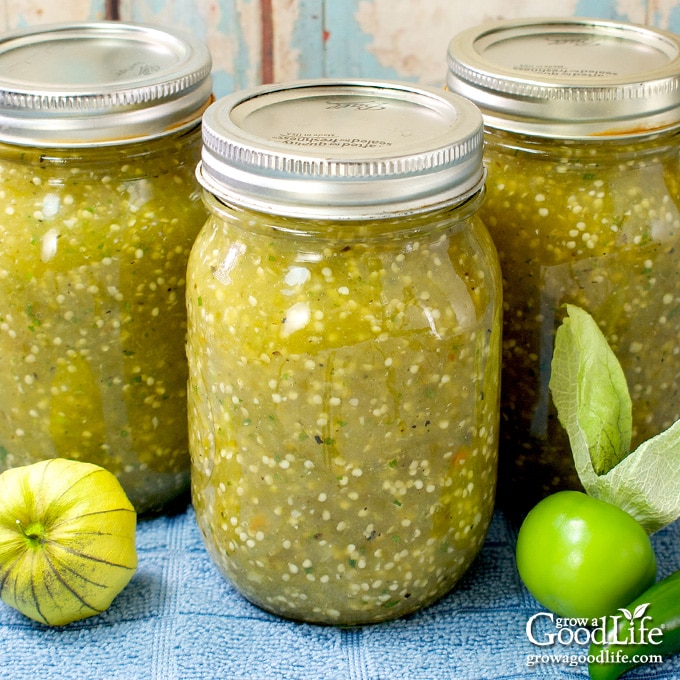
The first time I grew tomatillos in the garden, I thought six plants would be a good number to grow. Ok, ok, I hear the snickers from those of you with experience growing tomatillos.
Tomatillos (Physalis philadelphica), also called husk tomatoes, are native to Mexico and are not very common to our corner of the world, Maine. They are related to the tomato, but grow enclosed in a papery husk.
Tomatillos produce a lot of fruit even when growing in cooler climates, so consider yourself warned if you are thinking of growing some for the first time. Each plant can put out about ten to fifteen pounds.
On a positive note, I had a lot of tomatillos to experiment with. Biting into my first ripe fruit was an unexpected pleasure. I thought it would taste similar to a tomato. Instead, it has a tart and slightly citrus flavor.
The first thing I tried is making with tomatillos was a small batch of salsa verde. It was good! Then I tried roasting it. Roasting the vegetables adds a delicious smoky flavor and mellows the acidity of the tomatillos: Small Batch Roasted Salsa Verde Recipe.
Finding a safe canning recipe for salsa verde that tasted good was challenging. In fact, the recipe I published here previously from the NCHFP website required bottled lemon juice to make it safe for home canning. Many commented that there was too much lemon flavor, and I had to agree.
Finally, I tried a salsa verde recipe from The All New Ball Book of Canning and Preserving that uses fresh lime juice and cilantro. I tested it several times, and it tastes so much better. If you tried the old recipe and were disappointed with the lemon flavor, please give this one a shot.
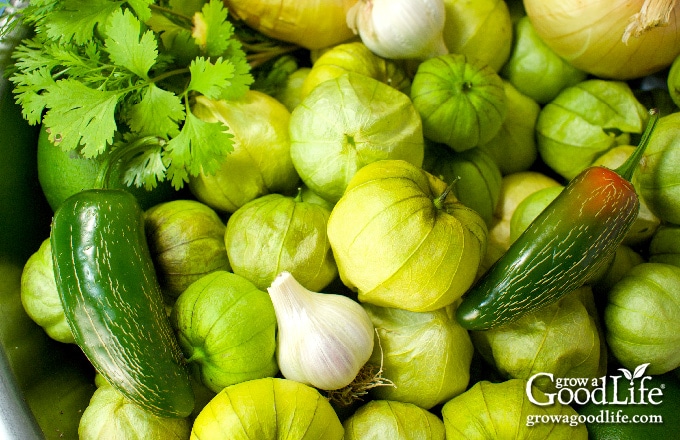
This roasted tomatillo salsa is delicious as a dip with tortilla chips, drizzled on tacos and fajitas. We also like it pouring it over some boneless chicken breasts and cooking in a crockpot to make shredded chicken for salsa verde chicken enchiladas similar to this recipe.
Steps for Canning Roasted Tomatillo Salsa
Tomatillos are easy to preserve into jars of salsa verde. There is no peeling or seeding, simply roast the vegetables, combine the ingredients, blend together, simmer briefly, and process in a water bath canner.
When canning, it is important to follow a recipe that has been scientifically tested. This is the “Roasted Salsa Verde” recipe from The All New Ball Book of Canning and Preserving. It has been doubled for a canner load of 6 pint-sized jars, and the seasonings have been adjusted.
If you are new to canning, it may be helpful to review this article on water bath canning at the National Center for Home Food Preservation website.
A more detailed and printable recipe can be found at the bottom of this article. These are the illustrated steps for making and preserving roasted tomatillo salsa in a water bath canner:
Step 1: Gather the Kitchen Equipment
- 4 rimmed baking sheets or a large roasting pans to roast the vegetables
- Rubber gloves for handling hot peppers
- Food processor to blend the salsa
- Kitchen scale
- Water bath canner and canning rack
- 6 pint sized canning jars
- Canning lids and bands (new lids for each jar, bands can be reused)
- Canning tools: jar lifter, canning ladle, funnel, and bubble popper
- Plus basic kitchen supplies such as a large prep bowl, large saucepan, towels, knife, and a cutting board.
Step 2: Prepare the Vegetables
Peel the husks off the tomatillos and rinse them well to remove the sticky residue. Cut the tomatillos in half and add to the roasting pans. Peel and cut your onions into chunks, wash the jalapeño peppers and add them whole to the roasting pans. Peel your garlic and scatter them over the vegetables.
Roast the vegetables in a preheated oven until everything is softened and charred, about 15-20 minutes. Flip half way through so the vegetables roast evenly. Remove the pan from the oven and let it cool for 5-10 minutes.
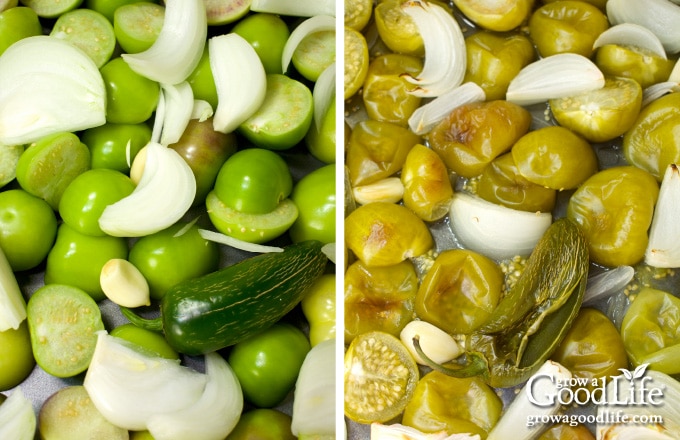
Step 3: Prepare the Canning Jars and Lids
While the vegetables are roasting, prepare the jars, set up the canner, and organize your work area.
Wash your canning jars, lids and bands, and canning tools with warm, soapy water and rinse well. Look the jars over carefully, and eliminate any with chips and cracks. Set lids and bands aside until you are ready to use them.
Place the canner on the stove and insert the canning rack. Set the jars in the canner, add water to cover, and simmer (180˚F) for 10 minutes. Keep hot until you are ready to fill them.
Step 4: Make the Salsa Verde
While wearing gloves, remove stems and seeds from the jalapeño peppers. You can keep the seeds if you like more heat.
Working in batches, add the roasted vegetables and their liquid to a food processor. Process until smooth, and then pour into a large sauce pot. Continue processing the vegetables in batches until done.
Add the lime juice, cilantro leaves, salt, pepper, cumin and stir to combine. Bring the pot to a simmer (180˚F), and then turn the heat to low and keep warm.
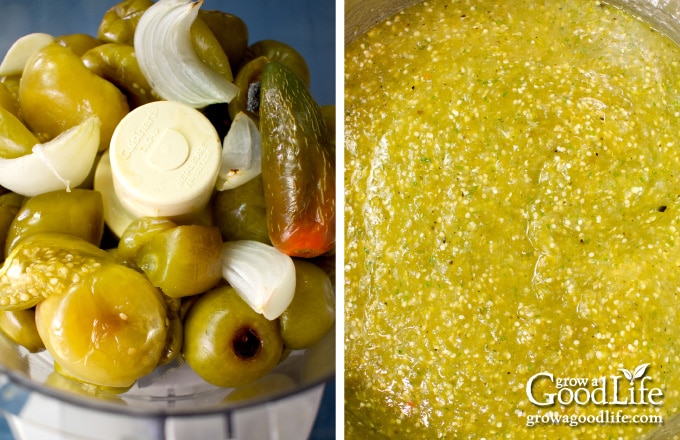
Step 5: Can the Salsa
Spread a dry kitchen towel on the counter. Use the jar lifter to remove a hot jar from the canner, drain, and place on the towel. Keep the remaining jars in the canner, so they stay warm.
Place the canning funnel on the jar, and ladle the hot salsa into the jar while leaving 1/2-inch headspace. Run the bubble popper through the jar to release any trapped air bubbles. Adjust the headspace again if needed.
Wipe the rim with a damp towel to remove residue. Center a lid on the jar, add the band, and screw it on until fingertip tight. Place the jar back into the canner, and repeat with the rest of the jars.
Adjust the water level so it is covering the jars by two-inches, cover the canner, bring it to a boil, and process the jars in a boiling-water canner for the times indicated in the recipe below.
Once processing time is complete, remove the jars, and let them cool undisturbed for 12 to 24 hours. After cooling for at least 12 hours, test the seals. Refrigerate any that did not seal, and use up within a week.
Wash the jars with warm soapy water, dry, label and date the jars, and store in a cool, dark location for 12 to 18 months. Wait several weeks for the salsa to develop its flavor before opening a jar.
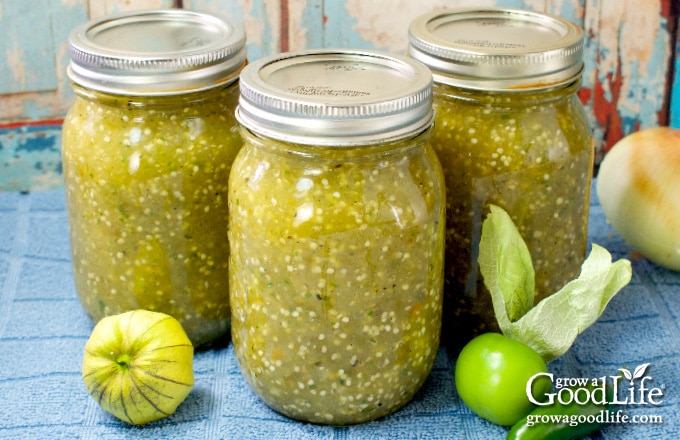
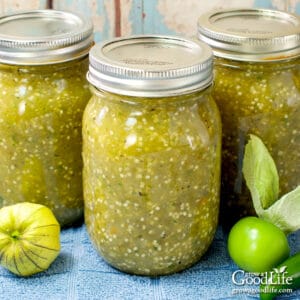
Roasted Tomatillo Salsa Verde Canning Recipe
Ingredients
- 8 pounds tomatillos husks removed
- 4 medium white onions cut into wedges
- 4 jalapeño chiles or serrano peppers
- 6 cloves garlic peeled
- 1 cup fresh lime juice or bottled lime juice
- 1/2 cup chopped fresh cilantro leaves
- 2 teaspoons kosher salt (optional for flavor)
- 1 teaspoon black pepper (optional for flavor)
- 1/2 teaspoon ground cumin (optional for flavor)
Instructions
Prepare the Vegetables:
- Preheat oven to 425˚F.
- Peel the husks off the tomatillos and rinse them well. Cut the tomatillos in half and divide up into the rimmed baking sheets or roasting pans.
- Peel and cut your onions into chunks. Add to the roasting pans.
- Wash the jalapeño peppers and add them whole to the roasting pans.
- Peel your garlic, and scatter into the roasting pans.
- Roast the vegetables in a preheated oven until everything is slightly softened and charred, about 15-20 minutes. Flip half way through so the vegetables roast evenly.
- Remove the baking sheets from the oven and let the roasted vegetables cool for 5-10 minutes.
Prepare your Canning Equipment:
- Wash your jars, lids, screw bands, and canning tools in hot soapy water. Rinse thoroughly to remove all suds. Set aside to air dry on a clean kitchen towel.
- Place the jar rack into water bath canner, place jars in the canner, and add water to cover. Bring the canner to a simmer (180˚F) for 10 minutes, and keep the jars hot until you are ready to fill them.
Make the Tomatillo Salsa Verde:
- While wearing gloves, remove stems and seeds from the jalapeño peppers. You can keep the seeds if you like more heat.
- Working in batches, add the roasted vegetables and their liquid to a food processor. Process until smooth, and then pour into a large sauce pot. Continue processing the vegetables in batches until done.
- Add the lime juice, cilantro leaves, salt, pepper, cumin, and stir to combine. Bring the pot to a simmer (180˚F), and then turn the heat to low and keep warm.
Can the Roasted Tomatillo Salsa Verde:
- Lay a dry kitchen towel on the counter. Use the jar lifter to remove a jar from the canner. Drain the water back into the canner, and place on the towel. Keep the remaining jars in the canner so they stay hot.
- Use the canning funnel and ladle to fill the jar with hot relish, leaving 1/2-inch headspace.
- Wipe the rim to remove any residue, center a lid on the jar, and screw on a band until it is fingertip tight. Use the jar lifter to place the jar back into the canner, and repeat with the remaining jars.
- Once all the jars are in canner, adjust the water level so it is two inches above the jar tops.
- Cover the canner and bring to boil over high heat. Once water boils vigorously, continue boiling for 20 minutes at altitudes of less than 1,000 feet. Adjust processing time for your altitude if necessary (See Notes).
- When processing time is complete, turn off the heat, and let the canner cool down and settle for about 5 minutes.
- Spread a dry kitchen towel on the counter. Remove the cover by tilting lid away from you so that steam does not burn your face.
- Use the jar lifter to remove the jars from canner and place on the towel. Keep the jars upright, and don't tighten bands or check the seals yet. Let sit undisturbed for 12 to 24-hours to cool.
- After 12 to 24-hours, check to be sure jar lids have sealed by pushing on the center of the lid. The lid should not pop up. If the lid flexes up and down, it did not seal. Refrigerate jar and use up within a week.
- Remove the screw on bands and wash the jars. Label, date, and store in a cool, dark place for 12 to 18 months. Allow at least 3 to 4 weeks for the salsa to develop its flavor. Once the jar is open, refrigerate and use up within a week. Yields about 6 pints.
Notes
Nutrition
This recipe was originally published July 29, 2018. It has been updated with new photos, more detailed information, and a much better tasting safe canning recipe.
You May Also Like:
- Zesty Salsa Recipe for Canning
- How to Can Tomatoes
- Seasoned Tomato Sauce Canning Recipe
- How to Can Poultry Meat
If you love salsa, consider adding our eBook, Grow a Good Life Guide to 50 Salsa Canning Recipes, to your resource library. This 72-page eBook is packed with a variety of delicious salsa recipes, including classic tomato salsas to roasted and grilled salsas to tomatillo and delicious fruit blends, all safe for water bath canning. It’s the perfect guide to help you preserve your garden harvests.

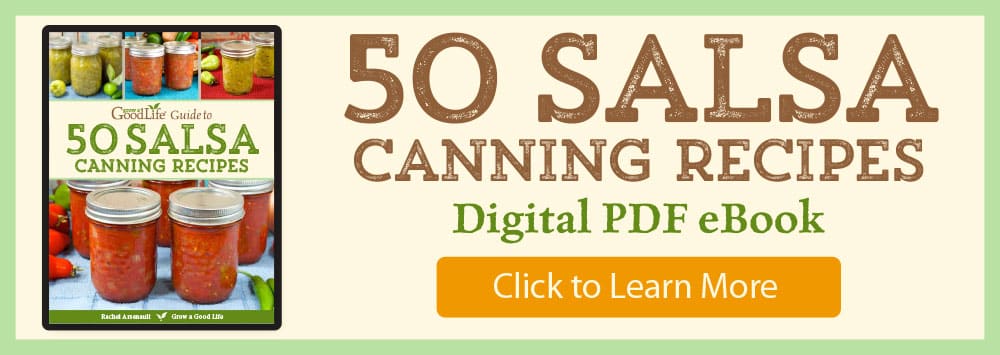
I had some tomitillos given to me and I made salsa Verde for the first time. I used serrano peppers and its spicy but I like it that away. Will make it again if I have more tomitilos.
Hello! I’m gearing up to make this, I have questions. In the past with my red salsa recipe it was decided that 4 jalapeños was like 1/2 of peppers. So, as long as I used a half a cup of any peppers, I was good on the acid. What would be the equivalent here? Also, some of my tomotillos are yellow, will it be okay to use em? I’m a pund away from getting this going! Excited!
Hello Sidney! I’m glad you’re excited to try this recipe. In terms of peppers, since your previous experience indicates that 4 jalapeños equate to about 1/2 cup of peppers in terms of acidity, you can use the same approach here. Aim for approximately 1/2 cup of any peppers to maintain the acidity level. As for the tomatillos, using yellow ones should be perfectly fine. Some varieties turn a bit yellow when they mature. I hope you enjoy the salsa.
One more question, the size of peppers varies greatly. Serranos are typically smaller than jalapenos. Jalapenos vary from 15 to 25 grams. Do I need to be concerned about the size of the peppers? I would like to use grams instead of number of peppers which would take me anywhere from 60 to 100 grams with seeds and stems. I do know an average onion yields 1 cup of chopped onion. Am I over thinking this? Thanks, CIndy
Cindy, using grams to measure the peppers is a great idea for precision. Generally, in canning recipes, it’s safe to interchange pepper types as long as the total quantity remains consistent. Since Ball developed this recipe using 4 whole jalapeños, they would have accounted for some wiggle room as to size. Using a consistent weight like 20 grams should work well. I am guessing that will be about 5 to 6 whole Serrano peppers to replace the 4 jalapeños. You’re not overthinking it – accuracy in measurements is important for achieving the proper balance in your canning recipe. Please reach out again if you still have questions.
Hello, this recipe looks great, but I have a question about the spice. I’d like to add Mexican oregano and perhaps increase the cumin, I am thinking of adding 3 T dried Mexican oregano and increasing the cumin to 1 T. Any thoughts? Thanks you, CIndy
Cindy, Yes, it is safe to adjust the dried herbs and spices in this recipe. I hope your salsa turns out wonderfully delicious!
Can this recipe be doubled, or is it best to make single recipes?
Hilary, Yes, the recipe can be doubled. 🙂
So good! I’m sad that one of my jars’ lids came completely off during the water bath. I’ve never had that happen! Glad I planted several tomatillos and jalapeño peppers. Thanks!!
Becky, I’m thrilled to hear that you enjoyed the recipe! I’m sorry to hear about the lid mishap during the water bath. It can be frustrating when that happens, and I would recommend discarding the ring that you used for the jar with the loose lid. Sometimes the threading on the rings can be defective, which may have contributed to the lid coming off. I’m glad you have extra tomatillos and jalapeño peppers to make up for it.
Thanks for the tip on the lid! I hope I can find it. I’ve canned green beans and cowboy candy since then 🙄😂
This recipe turned out so well! We had some weather challenges this year with a wetter than normal spring. But, I got 4 lbs of tomatillos and halved the recipe. I love the lime, cilantro and cumin flavors and the bite of jalapeño. Really, really good. Also, great directions on the canning steps. This is just my second year of canning produce, and the detailed instructions made a positive difference. Thank you, ZoeV
Zoe, I am so happy you enjoyed the recipe!
I still have the older Ball canning book so hadn’t seen this recipe – terrific idea to roast! I used bottled lime juice because it was less expensive and I am assured an even acidity level. Also from Maine, I planted my tomatillos too late to get as many as I wanted (I planted 2 plants!) so used green tomatoes to round out the 8 pounds (planted those late too!) It tastes delicious. Thanks for sharing!
I just made this recipe, and it is absolutely delicious! The only change I made was to lightly toast cumin seeds before grinding. I’m not sure if it changed the final flavor, but either way, it’s great. I’ll never be afraid to plant too many tomatillos again lol
Hi,
This recipe is very close to my usual for salsa verde so I’m very excited to can it with some fresh market tomatilllos. If I’m worried about not having enough acid from the limes I have, can I add 1/4 teaspoon of citric acid per pint just to be sure? Many other recipes I’ve seen call for adding white vinegar as well as the lime juice. And fresh lime juice can have an unpredictable acidity. Thanks in advance for your time.
Bry, This is a tested safe canning recipe from The All New Ball Book of Canning and Preserving. In the book, Ball states, “… Be assured that any recipe that calls from fresh lemon or lime juice has been thoroughly verified safe…”
Please follow the recipe. It was developed, lab tested, and deemed safe as written. If you are not comfortable using fresh limes, you can use bottled lime juice. Currently, there are no lab tested salsa recipes that use citric acid so it is unknown if or how it affects the acidity.
This is close to my salsa verde recipe except that I add more spice . Can I safely add double the amount of peppers ?
Tatiana, I’m glad you enjoyed the recipe! While you can add more dried spices for extra heat, it’s essential to be cautious when altering the amount of peppers in a canning recipe. Modifying the recipe may impact its acidity level, making it unsafe for canning. If you prefer to add more peppers, I recommend freezing the salsa instead.